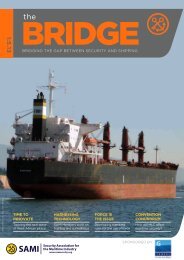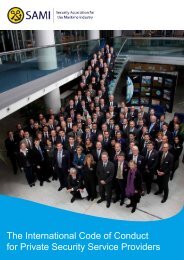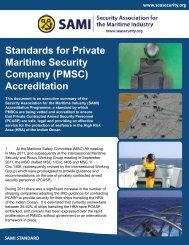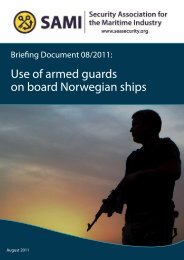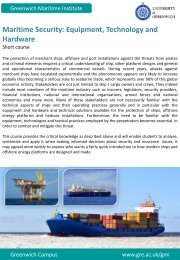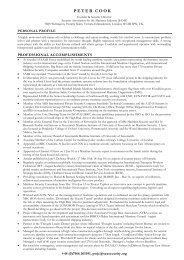SAMI Briefing Maritime Labour Convention FAQs and Text March 2013
SAMI Briefing Maritime Labour Convention FAQs and Text March 2013
SAMI Briefing Maritime Labour Convention FAQs and Text March 2013
You also want an ePaper? Increase the reach of your titles
YUMPU automatically turns print PDFs into web optimized ePapers that Google loves.
Accommodation, recreational facilities, food <strong>and</strong> cateringwhen seafarers are living or working on board <strong>and</strong> conditions so require. However, thispower need not be provided from an emergency source.Guideline B3.1.3 – Heating1. The system of heating the seafarer accommodation should be in operation atall times when seafarers are living or working on board <strong>and</strong> conditions require its use.2. In all ships in which a heating system is required, the heating should be bymeans of hot water, warm air, electricity, steam or equivalent. However, within the accommodationarea, steam should not be used as a medium for heat transmission. Theheating system should be capable of maintaining the temperature in seafarer accommodationat a satisfactory level under normal conditions of weather <strong>and</strong> climate likelyto be met within the trade in which the ship is engaged. The competent authorityshould prescribe the st<strong>and</strong>ard to be provided.3. Radiators <strong>and</strong> other heating apparatus should be placed <strong>and</strong>, where necessary,shielded so as to avoid risk of fire or danger or discomfort to the occupants.Guideline B3.1.4 – Lighting1. In all ships, electric light should be provided in the seafarer accommodation.If there are not two independent sources of electricity for lighting, additional lightingshould be provided by properly constructed lamps or lighting apparatus for emergencyuse.2. In sleeping rooms an electric reading lamp should be installed at the head ofeach berth.3. Suitable st<strong>and</strong>ards of natural <strong>and</strong> artificial lighting should be fixed by thecompetent authority.Guideline B3.1.5 – Sleeping rooms1. There should be adequate berth arrangements on board, making it as comfortableas possible for the seafarer <strong>and</strong> any partner who may accompany the seafarer.2. Where the size of the ship, the activity in which it is to be engaged <strong>and</strong> its layoutmake it reasonable <strong>and</strong> practicable, sleeping rooms should be planned <strong>and</strong>equipped with a private bathroom, including a toilet, so as to provide reasonable comfortfor the occupants <strong>and</strong> to facilitate tidiness.3. As far as practicable, sleeping rooms of seafarers should be so arranged thatwatches are separated <strong>and</strong> that no seafarers working during the day share a room withwatchkeepers.4. In the case of seafarers performing the duty of petty officers there should beno more than two persons per sleeping room.5. Consideration should be given to extending the facility referred to in St<strong>and</strong>ardA3.1, paragraph 9(m), to the second engineer officer when practicable.6. Space occupied by berths <strong>and</strong> lockers, chests of drawers <strong>and</strong> seats should beincluded in the measurement of the floor area. Small or irregularly shaped spaceswhich do not add effectively to the space available for free movement <strong>and</strong> cannot beused for installing furniture should be excluded.47





